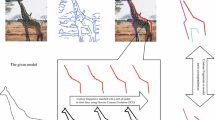Abstract
In areas of artificial intelligence and computer vision, object representation and recognition is an important topic, and lots of methods have been developed for it. However, analysis and obtain the knowledge of object’s structure at higher levels are still very difficult now. We draw on the experience of pattern recognition theories of cognitive psychology to construct a compact, abstract and symbolic representing model of object’s contour based on components fitting which is more consistent with human’s cognition process. In addition, we design an algorithm to match components between different images of the same object in order to make the feature extraction at higher levels possible.
Access this chapter
Tax calculation will be finalised at checkout
Purchases are for personal use only
Preview
Unable to display preview. Download preview PDF.
Similar content being viewed by others
References
Lowe, D.G.: Distinctive image features from scale-invariant keypoints. International Journal of Computer Vision 60(2), 91–110 (2004)
Jain, A.K., Duin, R.P.W., et al.: Statistical pattern recognition: A review. IEEE Transactions on Pattern Analysis and Machine Intelligence 22(1), 4–37 (2000)
Twining, C., Taylor, C.: The use of kernel principal component analysis to model data distributions. Pattern Recognition 36(1), 217–227 (2003)
Chen, B., Liu, H., et al.: A kernel optimization method based on the localized kernel Fisher criterion. Pattern Recognition 41(3), 1098–1109 (2008)
Weisstein, N., Harris, C.S.: Visual detection of line segments: An object-superiority effect. Science (1974)
Marr, D., Nishihara, H.K.: Representation and recognition of the spatial organization of three-dimensional shapes. Proceedings of the Royal Society of London. Series B. Biological Sciences 200(1140), 269–294 (1978)
Biederman, I.: Recognition-by-components: a theory of human image understanding. Psychological Review 94(2), 115 (1987)
Biederman, I.: Recognizing depth-rotated objects: A review of recent research and theory. Spatial Vision 13(2-3), 2–3 (2000)
Chen, L.: Topological structure in visual perception. Science (1982)
Chen, L.: The topological approach to perceptual organization. Visual Cognition 12(4), 553–637 (2005)
Author information
Authors and Affiliations
Editor information
Editors and Affiliations
Rights and permissions
Copyright information
© 2013 Springer-Verlag Berlin Heidelberg
About this paper
Cite this paper
Wei, H., Wang, Z. (2013). An Object Representation Model Based on the Mechanism of Visual Perception. In: Ali, M., Bosse, T., Hindriks, K.V., Hoogendoorn, M., Jonker, C.M., Treur, J. (eds) Recent Trends in Applied Artificial Intelligence. IEA/AIE 2013. Lecture Notes in Computer Science(), vol 7906. Springer, Berlin, Heidelberg. https://doi.org/10.1007/978-3-642-38577-3_13
Download citation
DOI: https://doi.org/10.1007/978-3-642-38577-3_13
Publisher Name: Springer, Berlin, Heidelberg
Print ISBN: 978-3-642-38576-6
Online ISBN: 978-3-642-38577-3
eBook Packages: Computer ScienceComputer Science (R0)




